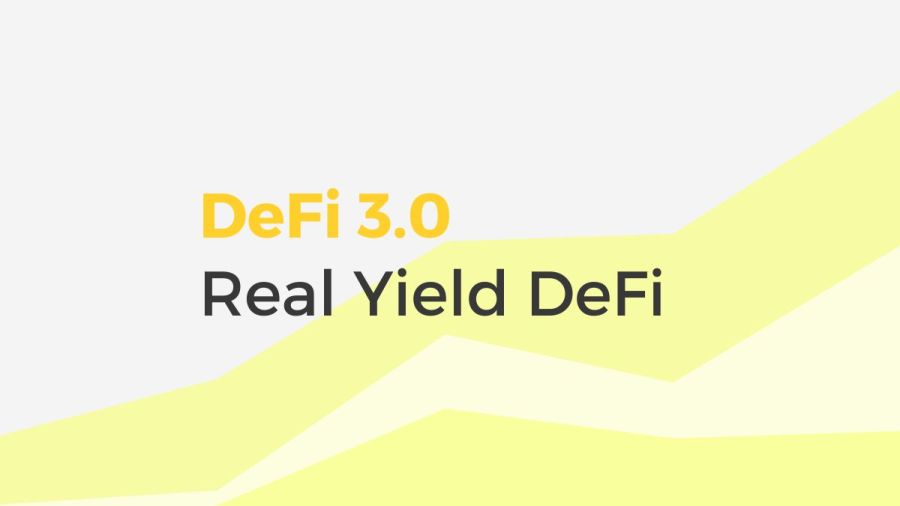New narrative: What is “Real Yield Defi”?
CryptoPress
Real yield is the yield earned by the creation of real protocol income, like as trading fees. Token holders on the system may earn a portion of this yield, similar to dividend stock. In the narrative of decentralized finance, real yield would be the third evolution of Defi, or Defi 3.0.
Thus, betting on a “real yield” protocol means relying on its ability to maintain its user base and transaction volume, its value, in short, over time. There is no better return on your money than this.
These tokens are similar to equities that pay out a cash dividend to holders: This is the meaning of the phrase “Real Yield,” which alludes to the similarities between these tokens and dividend-paying stocks. Some businesses generate income in unique ways.
The most significant advance is the elimination of the Ponzi-like nature of all 2021 programs. In these cases, real return is comparable to the rate of interest paid for equity ownership in a project.
Staking or locking governance tokens gives holders access to real yield, which is a percentage of the protocol’s earnings represented in a fiat currency like ETH or USDC. If a dividend is what you’re thinking about, you wouldn’t be far off.
Cash flow in ETH
Cash flow in ETH or stablecoins is a nice change for many Defi users who are still holding governance tokens after their value dropped by 80% or more from their all-time high.
When compared to the Ponzi-like APYs of 2021, when four-digit rates were taken in stride, the notion of genuine yield stands in stark contrast. A large part of the motivation for such returns came from the native tokens of various projects, which were doled out at unsustainable rates in the hopes of attracting user deposits.
Tokens and services promising grossly inflated unsustainable, sometimes triple-digit yearly income has long diverted DeFi’s attention. In order to quickly build a protocol with sufficient liquidity, users, and overall value, this paradigm became widely used (TVL).
Cash flow in ETH or stablecoins is a nice change for many DeFi users who are still holding governance tokens after their value dropped by 80% or more from their all-time high.
Users of DeFi were jumping from project to project, investing assets in exchange for token awards, and then quickly selling those tokens on the secondary market. In 2020 and 2021, this kind of farming, known as yield farming, generated substantial profits.
These rates, although appealing to traders, were unfortunately maintained by “false yield,” or token emissions. What this means is that they necessitated creating fresh tokens inside the system and rewarding users with them.
As long as a token’s price rises to back up its juicy APR, this necessity may be avoided to some extent. However, this really never occurs. Price momentum may be halted and even reversed by profit taking, changes in investor mood, and higher rates on other DEXs.
To maintain its ecosystem and maintain its returns, the project will be compelled to issue additional tokens. But this merely causes the token’s value to plummet even further, scaring off even more investors and accelerating the ecosystem’s downward cycle.
“Fake yield” projects have an extremely high failure rate and a short lifetime. Inconvenient reminders of this truth include networks like Terra and the subsequent failure of TerraUSD and LUNA.
Real yield initiatives, on the other hand, depend on value accrual methods that can only work with a substantial and consistent user base.
Now, opinion leaders are praising initiatives for their actual returns, and several platforms have been praised for sharing their profits with their customers.
Instilling Confidence Once Again
The DeFi ecosystem is still striving to earn customers’ confidence since there are numerous valid reasons for people to be wary. DeFi’s credibility has taken a hit due to high-profile failures like Terra and Celsius.
There will always be an attempt to optimize for each new measure that may be utilized as a useful marketing tool. As the story of genuine yield plays out, its authors want to put it in the right perspective.
Others aren’t so confident
However, as the idea gains popularity, others are worried that “real yield” may become a signaling metric rather than a measure of a protocol’s financial health.
For example, Redacted Cartel’s co-founder and one of the true yield protocols, 0xSami, is skeptical.
“I believe in the same way that TVL (total value locked) is a false statistic, we should not consider the ETH APY as the genuine indicator,”. The entire value of all assets included under the smart contracts of a certain protocol is known as its “total locked value” (TVL). Despite its usefulness in indicating a protocol’s scale, the measure is easy to rig by incentivizing deposits with excessively large amounts of tokens. Even more importantly, TVL doesn’t inquire into the efficacy of the investment.
For 0xSami, there are two key dangers associated with optimizing for actual yield, even if the APY is in the low two-digit range, which is still considered to be appropriate. One is that a token emission is still an option for companies seeking funding. Even if consumers are getting the actual income via staking a fast-increasing governance token, projects may still brag about their ETH or USDC-denominated real yield.
It may be sneaky to force users to store their tokens in a locked wallet while simultaneously delaying token issuance. In this case, projects might argue that a protocol is economically viable because of the low emissions-to-revenue ratio.
Emissions, for instance, might be scheduled to spike six months from now. This results in a decrease in value for users’ still-locked tokens, maybe even more than the so-called genuine yield users got.
Not a meme
Umami Labs’ CEO Alex O’Donnell has told that although token emissions in and of themselves aren’t terrible, using them to drive financial activity and then labeling part of that activity as “real yield” goes against the spirit of the movement.
The CEO of Umami said, “Real yield is not only a meme, but it is not something that lives in isolation.” This reminds us of TVL, which has its uses but isn’t a silver bullet for gauging the efficacy of DeFi techniques.
Using a yield-generating approach that incorporates the GMX perpetual exchange and the Tracer derivatives platform, Umami produces yield for UMAMI depositors.
O’Donnell warned that the meaning of a term may be watered down if it were portrayed as desirable.
Image: Cryptopress © 2022.
© 2024 Cryptopress. For informational purposes only, not offered as advice of any kind.
Latest Content
- Crypto Market Update: Insights and Trends for April 23, 2024
- On April 24, the $RTF Token from Oleksandr Usyk’s READY TO FIGHT Project Will be Listed on WhiteBIT
- Crypto Market Update: Key Trends and Insights for April 22, 2024
- NAGA’s Shareholders Approve the Merger With CAPEX.com With a Positive Vote of 99.81%
- Bitcoin Network Fees Soar as Runes Launch Nears
Related
- MicroStrategy Announces Second Quarter 2021 Financial Results July 29, 2021 04:01 PM Eastern Daylight Time TYSONS CORNER, Va.–(BUSINESS WIRE)–MicroStrategy® (Nasdaq: MSTR), the largest independent publicly-traded business intelligence company, today announced financial results for the three-month period ended June 30, 2021 (the second quarter of its 2021 fiscal year)....
- Governance On-chain governance is a decentralized system for managing blockchain governance conflicts....
- Wonderland DAO – The Saga of Defi 2.0 The Wonderland saga continues in what seems to be the most interesting and relevant story in the Defi world....
- Crypto Events Archive A growing list of past crypto and blockchain events from around the world. Conferences, workshops, meetups, hackathons, conferences....




